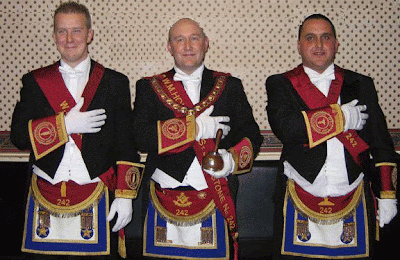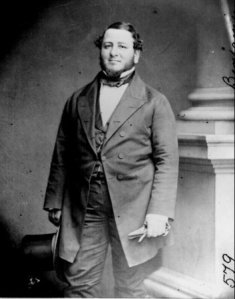Caveat Lector
CCC
http://theilluminatiwatch.com/tag/general-giuseppe-garibaldi/
EXCERPT: "In 1854, Gourgas assisted Freemason Killian Van Rensselaer in founding the Masonic front organization, the Knights of the Golden Circle in Cincinnati, Ohio. The Golden Circle immediately absorbed the Masonic operatives in Young America and became the military pre-organization of the Confederacy.45 The Knights of the Golden Circle rode west across Ohio, Indiana, and Illinois, then south along the Mississippi River to the Gulf of Mexico, and east into Maryland and Virginia. Along the way they opened castles (chapters) and signed up recruits. Freemason John Quitman opened a castle of the Knights in Jackson, Mississippi. Like-wise, Albert Pike opened one in New Orleans, through which Mazzini’s Mafia would later enter the United States following the Civil War.
One of the recruits initiated into the Knights of the Golden Circle was General and Freemason P.T. Beauregard (1818-1893), a West Point graduate of 1838, and brother-in-law of Louisiana’s political boss, Freemason John Slidell. Beauregard is credited with starting the Civil War with his surprise attack on Fort Sumter in 1861.
Long before Fort Sumter, however, Caleb Cushing realized that the anti-slavery north and the pro-slavery south were too far removed geographically to start a civil war over slavery. A division between neigh¬bors in close proximity had to be created before a war would break out nationally. Such a division was guaranteed by the first order of congressional business during the Pierce Administration — the passage of the Kansas-Nebraska Act. This act called for the Nebraska Territory to be divided into the territories of Kansas and Nebraska, whose residents would then determine whether slavery would be permitted or not. When the bill passed, the terrible aftermath was predictable. Outrageous acts of murder and arson were committed mostly by the pro-slavery Missourians, and savage cold-blooded massacres were committed by white abolitionists under the command of John Brown.
What is little known about John Brown (1800-1859) is that he spent much of his adult life in secret societies, including the Oddfellows, Sons of Temperance, and the Freemasons. Brown was made a Master Mason in Hudson Lodge No. 68, Hudson, Ohio, on May 11, 1824, and he served as junior deacon from 1825 to 1826. He renounced Freemasonry in 1830, when anti-Masonic fervor swept the nation.” Caleb Cushing, however, viewed John Brown as the perfect candidate to bring about the insur¬rection of the Southern states. As an anti-Mason, Brown would never be suspected as being an agent of Freemasonry. John Brown had joined Mazzini’s Young America during the Pierce Administration, and was supported financially by the John Jacob Astor Masonic interest in Boston and New York. After receiving instructions from Caleb Cushing, John Brown deliberately set out to instigate civil war in America.
In January 1857, Freemason James Buchanan was elected president to replace Franklin Pierce. John A. Quitman, father of Mississippi Freemasonry and leader of the southern secessionists, was the repre¬sentative from Mississippi in the House of Representatives. Quitman was slated to be the next Sovereign Grand Commander of the Southern Jurisdiction of Scottish Rite Freemasonry, but on July 17, 1858, he suddenly died — by poisoning, according to Masonic authority.~ Quit-man’s intimate friend Albert’ Pike, the man groomed by Cushing to take over Southern Freemasonry, conducted a lodge of sorrows in Quit-man’s memory, and a year later was elected to fill the post that Quitman would have held. Albert Pike then became the leader of the Southern secessionists.
Masonry and the Southern Confederacy
After Buchanan was elected president, he appointed to government posts those who were sure to start the Southern revolt. To the post of attorney general, Buchanan appointed Freemason Edwin M. Stanton of Pennsylvania, who would later be implicated in the assassination of President Abraham Lincoln. Buchanan appointed Freemason Howell Cobb of Georgia as secretary of the treasury. In March 1860, Cobb was elevated to the 33rd degree, and appointed by Albert Pike, leader of the secessionists in Georgia and chairman of the convention which organized the Confederacy in Montgomery, Alabama.
To the post of secretary of war, Buchanan appointed Freemason John B. Floyd, of St. Johns Lodge No. 36 in Richmond, Virginia. Two weeks before the 1860 presidential elections, Floyd quietly concluded an agreement with South Carolina’s governor William Gist to sell 10,000 U.S. government rifles to his home state of South Carolina, In January 1861, Floyd was indicted in Washington, D.C., for giving aid while he was secretary of war to secessionist leaders. He demanded an immediate trial and that same month a committee of Masons from the House of Representatives exonerated him. That same year he was made brigadier general in the Confederate Army.
Buchanan’s vice president was Freemason John C. Breckinridge of Kentucky. Breckinridge was in attendance at the 1860 national conven¬tion of the Democratic party held at Charleston, S.C., the headquarters of the Southern Jurisdiction of Freemasonry. Presiding over the con¬vention was Northern Jurisdiction Freemason Caleb Cushing. Under Cushing’s supervision, the Gulf states delegation staged a walkout, formed their own convention, and elected Cushing as its chairman. The secessionists nominated Breckinridge as their candidate for president On March 28, 1860, while campaigning in Kentucky; Breckinridge received the 33rd degree from Albert Pike.
Meanwhile, the newly formed Republican party nominated Abraham Lincoln as its presidential candidate. Lincoln, not a Mason, won the election. That same year Breckinridge was elected U.S. Senator from Kentucky. At the beginning of the Civil War, Breckinridge defended the South in the Senate and soon entered the Confederate service, for which act he was expelled from the Senate on December 4, 1861. Freemason Jefferson Davis, president of the Confederate States, appointed Breckinridge as his secretary of war.
It seems likely that Albert Pike had instigated the process of secession immediately after Lincoln’s election. For example, on December 20,1860, the state of South Carolina, headquarters of the Southern Jurisdiction of Freemasonry, was the first state to secede. On that same day, the state of Mississippi, whose secessionist organization had been created by the late Scottish Rite leader, John A. Quitman, followed South Carolina’s lead. And on that same day, Freemason John Floyd, secretary of war under the still-presiding President Buchanan, performed another act of treason by ordering “the Allegheny arsenal at Pittsburgh to send 113 heavy columbiad cannons and eleven 32-pound cannons to the unfinished, undefended U.S. forts at Ship Island, Mississippi, and Galveston, Texas, where they could be seized by the insurrectionists.”
On December 22, 1860, the state of Florida followed suit and seceded from the Union, led by U.S. Senator David Levy Yulee, member of Hayward Lodge No. 7, Gainesville, Florida, The state of Alabama seceded on December 24, 1860,. On January 2, 1861, Georgia’s secession was led by two Freemasons, Howell Cobb, President Buchanan’s secretary of the treasury, and Robert Toombs, who became the first secretary of state of the Confederacy. Both men received the honorary 33rd degree after the Civil War. Louisiana’s secession occurred on January 7, 1861, led by two Freemasons, John Slidell and Pierre Soule. Soule also received the honorary 33rd degree after the Civil War. Backed by thousands of armed paramilitary Knights of the Golden Circle, Texas forced Governor and Freemason Sam Houston to secede in February, 1861. On April 12, 1861, General and Freemason P.T. Beauregard (1818-1893), a member of the Knights of the Golden Circle, was ordered to attack Fort Sumter, South Carolina, The American Civil War had begun. Anton Chaitkin writes:
After Lincoln unexpectedly ordered a national mobilization to crush the rebellion, the Knights of the Golden Circle engaged in paramilitary and espionage operations in the North, along with parallel and successor groups under different names — none, however, publicly carried its proper name: Ancient and Accepted Scottish Rite of Freemasonry.
All in all, eleven southern states seceded from the Union, yet the Confederate flag had 13 stars, a sacred Masonic number, signaling to those who understood that the secession of the Southern states was motivated by the Knights Templar’s Southern Jurisdiction of Scottish Rite of Freemasonry.
President Lincoln’s inauguration was held on March 4, 1861. Of the appointments to his cabinet, he made one fatal judgment. He appointed Freemason Edwin Stanton, Buchanan’s former attorney general, as his secretary of war. When Lincoln came to Washington to assume the presidency, Freemasonry’s armed Knights of the Golden Circle were foiled by General Winfield Scott in their first of two attempts to assassinate Lincoln. Stanton would be implicated in the second and fatal attempt."
The Knights of the Golden Circle Research and Historical Archives
http://groups.yahoo.com/group/Knights_of_the_Golden_Circle
http://knights-of-the-golden-circle.blogspot.com
http://knightsofthegoldencircle.webs.com
 "It's been a long time since I see you. Maybe you has forgot but I ain't forgot de fust time I put dese lookers on you, in '76. Does you 'members dat day? It was in a piece of pines beyond de Presbyterian Church, in Winnsboro, S. C. Us both had red shirts."
"It's been a long time since I see you. Maybe you has forgot but I ain't forgot de fust time I put dese lookers on you, in '76. Does you 'members dat day? It was in a piece of pines beyond de Presbyterian Church, in Winnsboro, S. C. Us both had red shirts."












